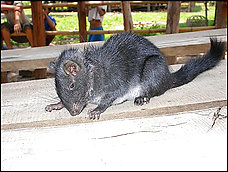Photos Taken of ‘Living Fossil’ in Laos
 (The Washington Post) The first pictures showing a live specimen of a rodent species once thought to have been extinct for 11 million years have been taken by a retired Florida State University professor and a Thai wildlife biologist. They took video and still photographs of the “living fossil,” which looks like a small squirrel or tree shrew, in May during an expedition to central Laos near the Thai border.Known as Diatomyidae, scientists have nicknamed it the Laotian rock rat. The creature is not really a rat but a member of a rodent family once known only from fossils.
(The Washington Post) The first pictures showing a live specimen of a rodent species once thought to have been extinct for 11 million years have been taken by a retired Florida State University professor and a Thai wildlife biologist. They took video and still photographs of the “living fossil,” which looks like a small squirrel or tree shrew, in May during an expedition to central Laos near the Thai border.Known as Diatomyidae, scientists have nicknamed it the Laotian rock rat. The creature is not really a rat but a member of a rodent family once known only from fossils.
Mystech: I have no doubt this supposed living fossil is actually the genetic creation of a well-meaning, but crazy billionaire reviving ancient species for marketing purposes. I dub this abomination… Jurassic Squirrel.
The pictures show a docile, squirrel-sized animal with dark dense fur and a long tail but not as bushy as a squirrel’s. It also shows that the creature waddles like a duck with its hind feet splayed out at an angle _ ideal for climbing rocks.
“I hope these pictures will help in some way to prevent the loss of this marvelous animal,” said David Redfield, a science education professor emeritus.
He and Uthai Treesucon, a bird-watching colleague, befriended hunters who captured a live rock rat after four failed attempts. They returned the animal, which the locals call kha-nyou, to its rocky home after photographing it.
The long-whiskered rodent was branded as a new species last year when biologists first examined dead specimens they found being sold at meat markets. But they had never seen a live animal until Redfield and Treesucon photographed it.
“These images are extremely important scientifically, showing as they do an animal (with) such markedly distinctive anatomical and functional attributes,” said Mary Dawson, curator emeritus of vertebrate paleontology at the Carnegie Museum of Natural History in Pittsburgh.
Dawson and colleagues in France and China first reported the rock rat’s true identity in the March 10 edition of the journal Science after they compared the bones of present-day specimens with fossils found in Asia.






